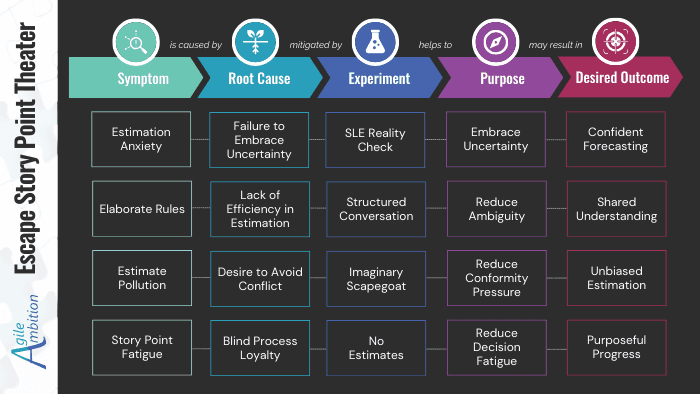Story Points Are Costing You More Than You Think.

Story Point Theater creates the illusion of progress while skipping the substance. It’s time to cut the act and simplify planning.

Does estimation feel like an empty ritual—appearing productive but failing to deliver real value? What if you could simplify planning, embrace experimentation, and refocus your team on meaningful outcomes?
In this issue, you’ll discover four experiments to help your team avoid the inefficiencies and pitfalls of story points.
From Estimation Anxiety to Confident Forecasting

On-the-spot estimates, like in Planning Poker, can feel stressful and force you to justify your number. Instead of focusing on numbers, use your SLE as a reality check. If most tasks finish in 3 days, ask: “Is there anything unusual or risky about this story that might prevent us from completing it in 3 days?” If yes, split it or address the risks; otherwise, move on. The goal isn’t perfect predictions but ensuring the work is right-sized. By managing known risks now and embracing uncertainty, you’ll achieve more accurate forecasts with less pressure.
The SLE Reality Check helps teams gain clarity by using data-driven benchmarks instead of guessing.
🤔 What would your team gain by focusing on risks and anomalies instead of debating numbers?
From Elaborate Rules to Shared Understanding

Once simple and straightforward, story pointing has become bogged down with unnecessary complexity. Fibonacci sequences, tie-breaking rules, and debates over numbers (is it a three or a five?) are now common, all in the name of efficiency. But while your team debates points, they’re not delivering value—or addressing ambiguity.
Why not ditch the rules around numbers and try structured conversations instead? Identify key questions for each work item—like potential risks or dependencies—and use them to guide discussion. This checklist-like approach reduces ambiguity, ensures shared understanding, and focuses on what matters: understanding the work, not debating estimates.
Structured conversations cut through complexity, replacing rules with meaningful discussions.
🤔 What key questions could your team use to uncover risks and dependencies during refinement?
From Estimate Pollution to Unbiased Estimation

Do you have that one teammate who gives a mini-speech about how a story is definitely a three-pointer—but says, “We can go ahead and estimate it anyway”? Magically, everyone throws up a three. Avoiding conflict stifles innovation and prevents valuable conversations.
One way to encourage productive conflict without creating tension is to establish an imaginary scapegoat. Enter Ron (not a real team member). Start with: “Ron thinks this is a 3.” It’s easier for the team to challenge Ron than each other, pointing out why he’s wrong. This strawman approach makes disagreements feel safer, reduces conformity pressure, and even builds team unity by rallying against a common (fictional) foe. The result? A more honest, unbiased estimation and better collaboration.
Imaginary scapegoats encourage honest input by reducing the fear of disagreement.
🤔 How often does your team avoid disagreements in estimation to maintain harmony, and what might you be missing as a result?
From Story Point Fatigue to Purposeful Progress

I’d be remiss if I criticized Story Point Theater without suggesting we might not need story points. Many teams suffer from story point fatigue, spending hours each week assigning points to every backlog item. But here’s the kicker: story points aren’t a core part of Scrum—they’ve just become so ingrained that teams go through the motions without questioning their value.
Ask yourself: Does our team genuinely benefit from this process? If the answer is no, consider trying a no estimates approach. Reduce decision fatigue, repurpose that time for meaningful work, and focus on purposeful progress over pointless rituals.
No estimates helps shift focus from assigning points to delivering real value.
🤔 Could letting go of story points help your team focus on outcomes rather than optics?
TLDR;
Story Point Theater is all show, no substance. If your gut tells you story points are wasting time without adding value, it’s time to ditch the theatrics and try new planning approaches.

Start experimenting today—your team will thank you.
Share
Table Of Contents
Fuel an Idea
Every week, I break down complex ideas, strip away the fluff, and give you experiments to turn knowledge into skills.
If that’s worth a coffee, consider fueling the next big insight.
No pressure. No guilt trips. Just impact.
Buy Me a CoffeeRelated Posts
Quick Links
Legal Stuff

